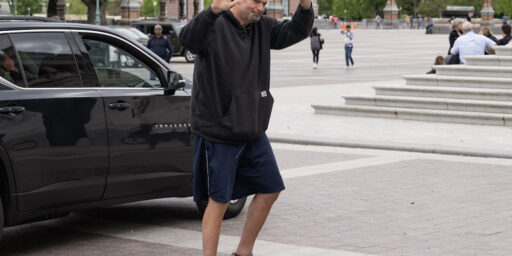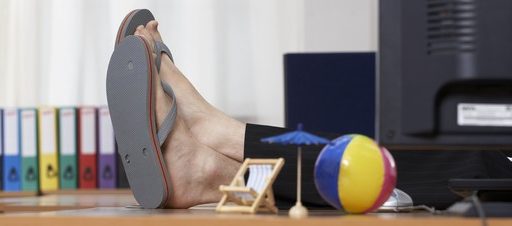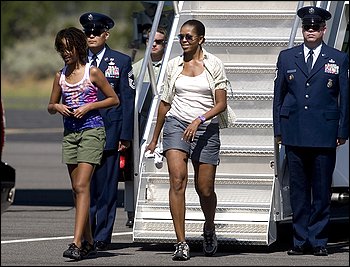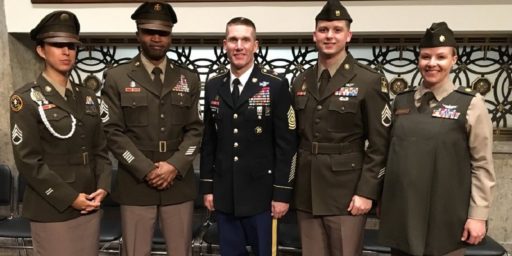Business Casual’s New Frontier: Shorts
While jackets and ties are becoming en vogue again in many firms, other companies are going in the other direction–allowing employees to wear shorts and flip-flops to the office to beat the heat.
Business Casual for Dog Days: Shorts (AP)
Just as one of the hottest summers in years started to sizzle, a Peoria, Ill.-based insurer took a bold step for a conservative company in a staid industry: It let its employees wear shorts to the office. Not just any shorts on any day, mind you. They must be the type worn to church or the boss’ barbecue, according to RLI Corp. Vice President Mike Quine, and the temperature has to be at least 90. “It creates a little different kind of culture,” said Quine, whose “Condition 90” memo in June proved one of his most popular ever with employees. “It makes people more relaxed.”
During heat waves at least, shorts in the office are the new frontier of business casual, the relaxed style of garb that began often substituting for suits and ties in the late ’80s and early ’90s. While Fortune 500 corporations are sticking with the long-pants look, some smaller firms across the country have loosened their policies to the point where what once was appropriate for the beach or the ballpark now works in the office too. “Work can be challenging enough without oppressive heat and humidity,” explained spokesman Kevin Dugan of Cincinnati-based FRCH Design Worldwide, an architecture and design firm whose 175 employees are encouraged to wear shorts on particularly sweltering days.
[…]
“I tend to think shorts are too casual,” said CEO Peter Handal of Dale Carnegie Training, a Hauppage, N.Y.-based firm that trains corporations in management and workplace issues. “That’s just not businesslike.” The most casual Handal ever dresses at work is khakis and a shirt with a collar and no tie. In any case, shorts and tank tops are hardly necessary in an air-conditioned office, he noted. “If you want to come to work in a T-shirt because it’s ungodly hot, then you just put on another shirt when you get there,” he said.
Despite the authorization of shorts at a few companies, the overall trend toward more casual attire may be slowing down. More employers have drawn up formal dress codes to ensure that workers don’t push relaxed standards too far, and recent survey results show a desire among employers to see the work force adopt more conservative fashions. Handal sees evidence that companies are actually getting dressier in the last couple of years, with Fortune 500 and other large firms becoming more formal in their business dress.
Similarly, business etiquette expert Lydia Ramsey has noticed a swing back toward business professional attire and away from business casual among the companies that hire her because ultra-casual creates sticky issues. The problem, she said, is “a lot of skin” — a loosening of standards that extends all the way to men showing chest hair and women showing cleavage, with sandals and flip-flops galore. “In the last few years in the summertime, people really do let go,” said Ramsey, who owns the firm Manners That Sell in Savannah, Ga. “Some companies are really trying to go back in the other direction” because their clients aren’t comfortable with it, she said.
But the bounds of what’s professional dress are a bit fuzzy these days. “It’s a real touchy issue to call someone into the office and try to tell someone that they aren’t dressed properly,” Ramsey said. “No one wants to do that.”
Quite right. Having an “understood” dress code wherein men wear shirts and ties and women wear knee-length skirts or pants suits eliminates the need to manage employees who lack basic social knowledge.
While I’ve worn a tie to work even when it was not expected, for example as a college professor, appropriate attire really depends on the work situation. There’s probably no reason to ask people to maintain an expensive, less comfortable wardrobe if they do not meet customers on a regular basis.
My fiance works for a political polling firm that has a very relaxed dress code, including shorts and flip-flops during the summer months, that manages to be highly successful. But they seldom meet clients in the office and they dress appropriately when they go out and meet the public.






What about co-workers? I really don’t want to see your bare feet at the office, so leave the flip-flops at home.
How you dress is a sign of the respect you have for yourself as well as the ones around you. You can still be comfortable and casual without looking like you are about to dive into a pool.
I wore flip-flops to the office once last week, but I’m 8 1/2 months pregnant and have very few shoes that will go on my feet at this point. Sorry, not pretty I know, but nobody said a thing. Good thing too. 🙂 (IMO, it’s an extenuating circumstance, like someone with a foot injury wearing tennis shoes for a while.)
James touches on one of the under-discussed reasons for the general trend of casual work attire — fewer meetings to attend. Since I graduated law school (15 years ago), the number of cases that actually go to trial has dropped substantially. So has the number of face-to-face meetings with clients and parties in contractual negotiations. So much is done by electronic communication that I can easily go a week or two at a time without seeing anyone other than co-workers. I agree with Whatever that we need to show respect for our co-workers too, but they don’t have quite the same expectations.
A former boss used to tell me that with casual dress comes casual work, and in my days as a manager I found it to be true.
And I find that my academic colleagues who wear jeans and birkenstocks are not taken seriously at all; I can only imagine how students would respond to shorts and flip-flops.
Your “academic colleagues who wear jeans and birkenstocks are not taken seriously at all”? At all?
Jeez, at Uptight University do the best ideas originate with tight shoes?
I’ve worked at several non-Ivy schools (wink) and have come across many attitudes towards professors’ dress. Most of these seem silly.
The guy who wears the suit on the first day of class and then jeans and hockey shirts the rest of the semester believes that he must set the proper tone on the first day.
The guy who wears the tie to teach in the business school thinks that it is proper to do so. Why? because the economics major is part of the business community?
Many people dress up so that they are taken more seriously by 18 year olds.
I understand dress codes at the busines firm. I don’t understand why we get uptight about what we wear to teach in.
If you wear jeans and birks to class and the students don’t take you seriously, I’d wager that it has more to do with what you are saying than what you are wearing.
If your colleagues don’t take your research seriously, then ditto.
If you wear the necktie and you look down your nose at others’ more casually dressed research and teaching, then I think you are missing the point about productivity in academics.
Consider this: A better question is how the jeans and birks crowd does when they get fed up with the uptight professors at uptight university and attempt to find a better job. Are there university’s out there that value the quality of research and teaching more highly than the superficialities of the dress code?
Dress codes in offices serve little to no purpose. Steve Jobs started Apple Computers in a garage and yet it became a large and highly profitable company.
The Robber Barons began the industrial age by building businesses and created great wealth for themselves. Dress codes stem from an effort by the few people in those businesses who benefited financially to separate themselves from the workers.
Wealth was required in order to afford formal dress. The business executives used dress codes as a way of keeping poor people out of management. This discrimination worked until labor unions increased the wages of the workers. The workers were finally able to afford better clothing and more people were able to get into executive offices.
The Dot com businesses of the 1990s proved that dress codes were meaningless. They helped push the larger businesses away from formal dress codes and into business casual.
If the larger businesses had not been violating U.S. laws there would not have been a bubble or a burst. The point here is that the companies with the dress codes created the bubble and the burst, but survived due to their cash reserves. None of this had anything to do with dress codes.
We need to spend less time worrying about what people wear to work and more time worrying about what our top executives are doing.
Women were a great influence in changing the dress codes as well. Women have only worn pants for 60 years and the fear of imposing rules on women have helped to reduce the dress codes in offices.
Take care,
Troy Iuliucci
Men’s Fashion Freedom
http://www.mensfashionfreedom.bravehost.com